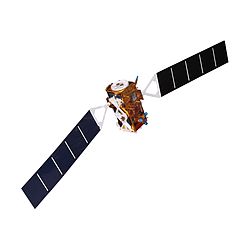Timeline
Background
Since the launch of TOPEX/Poseidon on 10 August 1992, high-precision satellite altimeters have been essential for monitoring how the ocean stores and redistributes heat, water, and carbon in the climate system. The Sentinel-6 program is a continuation of this series of measurements. First of the identical satellites, Sentinel-6 Michael Freilich, launched on 21 November 2020, [12] and the second, Sentinel-6B, was scheduled to launch 5 years later. [13]
They are designed to extend the legacy of the Jason satellite series satellite altimetry at least through 2030, which will provide a nearly forty-year record of the climate change-caused sea level rise [14] as well as changes in ocean currents. [13] [15] [16] [17] The third satellite, Sentinel-6C, is expected to launch in 2030s. [18] [19] [20]
Launch campaign
By 1 October 2025, the satellite was unpacked from its storage container and prepared for its launch campaign. [24] [23] Meanwhile at ESOC, the simulation campaign for the satellite's Launch and Early Orbit Phase (LEOP) started on 2 September 2025. [25] The launch was scheduled for 17 November 2025. [26] [27] [10] The spacecraft was encapsulated in its payload fairing on 10 November 2025. [28] On 15 November, it successfully passed its Launch Readiness Review. [29]
The Falcon 9 B1097.3 with Sentinel-6B launched from SLC-4E at Vandenberg Space Force Base at 5:21 UTC on 17 November 2025. [11] This was the third flight of this specific Falcon 9 first stage, which previously flew twice in 2025 on Starlink missions. [30] The first stage successfully landed on Landing Zone 4. [30] The satellite separated from the rocket's second stage just under an hour after liftoff. At 6:54 UTC, ESOC received the first signal from Sentinel-6B via the Inuvik ground station in Canada. [31]
In orbit
On 20 November 2025, EUMETSAT's Mission Control Centre in Darmstadt has officially taken control of the satellite. [32]
Partnership
Sentinel-6 was developed by European Space Agency (ESA) in the context of the European Copernicus Programme led by the European Commission, the European Organisation for the Exploitation of Meteorological Satellites (EUMETSAT), NASA, and the National Oceanic and Atmospheric Administration (NOAA), with funding support from the European Commission and technical support from France's National Centre for Space Studies (CNES). [34]
The mission definition is driven by the need for continuity in provision of TOPEX/Poseidon mission and Jason satellite series (Jason-1, OSTM/Jason-2, and Jason-3) with improvements in instrument performance and coverage. [35] ESA, NASA, and EUMETSAT provide mission management and system engineering support. EUMETSAT and NASA are responsible for long-term archives of altimetry data products. All partners were involved with the selection of science investigators. [35]
ESA has responsibility for procurement of Sentinel-6B on behalf of EUMETSAT and the European Commission, and for conducting the Launch and Early Orbit Phase (LEOP) of the satellite. ESA also supports flight operations performed by EUMETSAT.
EUMETSAT has responsibility for ground segment development and coordination at system level, including for operations preparation, for conducting operations of the satellite after LEOP performed by ESA, and for conducting operations of the European part of the ground segment, including processing of altimeter data and delivery of product services to European users.
NASA has responsibility for the development and delivery of the U.S. payload instruments, the microwave radiometer and the GNSS radio occultation receiver. NASA also provides launch services for the satellite and ground segment development support. NASA will contribute to operations and data processing on the U.S. side, including processing of GNSS radio occultation data, and together with NOAA, shares responsibility for the distribution of products to research and operational users in the U.S.
NOAA provides a U.S. ground station for tracking and command of the satellite and data downlinks. Togethre with NASA, NOAA shares responsibility for the distribution of products to research and operational users in the U.S.
CNES has responsibility for processing higher-level products (L2P, L3) and for providing precise orbit determination and support for Doris and altimeter operations. [33]
This page is based on this
Wikipedia article Text is available under the
CC BY-SA 4.0 license; additional terms may apply.
Images, videos and audio are available under their respective licenses.






